Spring 2025
Touch

The space in between things is often neglected. This session will explore the potential in between mind, hand and paper.
V. Sager
ECU Library
Learning
Commons
Learning
Commons
Fall 2024
the
SHADOW
CLUB
Sept 25 :: shadow anatomy

Oct 9 :: shadow meaning
Oct 23 :: shadow play
Nov 6 :: shadow mystery
Shadows are following us everywhere, casting our silhouettes on every surface and endlessly playing games with light.
PDF Shadows
V. Sager
ECU Library
Learning
Commons
Learning
Commons
Spring 2024
Jan30 Inner VisionFeb13 Synesthesia
Feb27 Soundscape
March12 AI drawing
Invisible drawing
Feb 13 2024
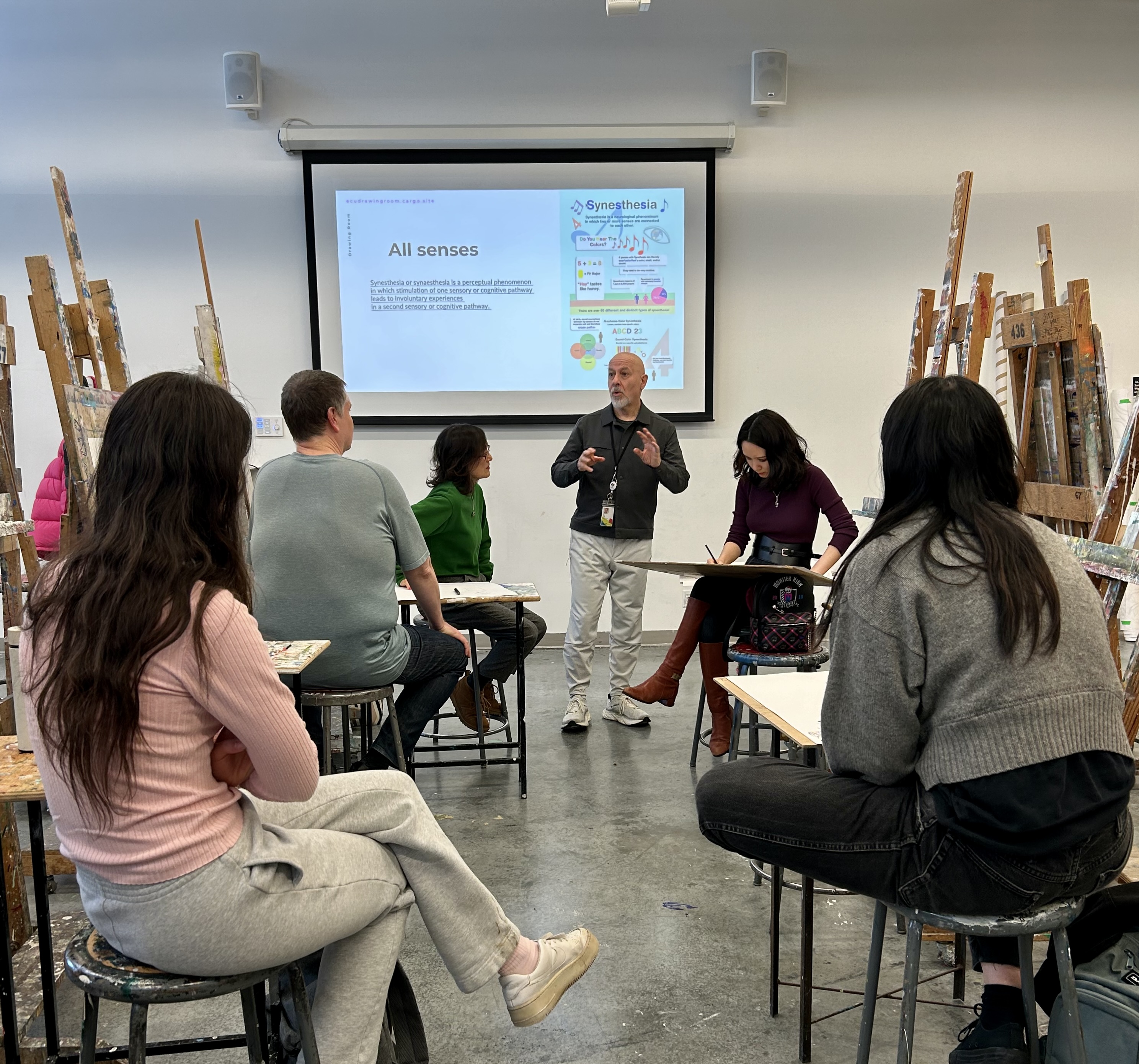



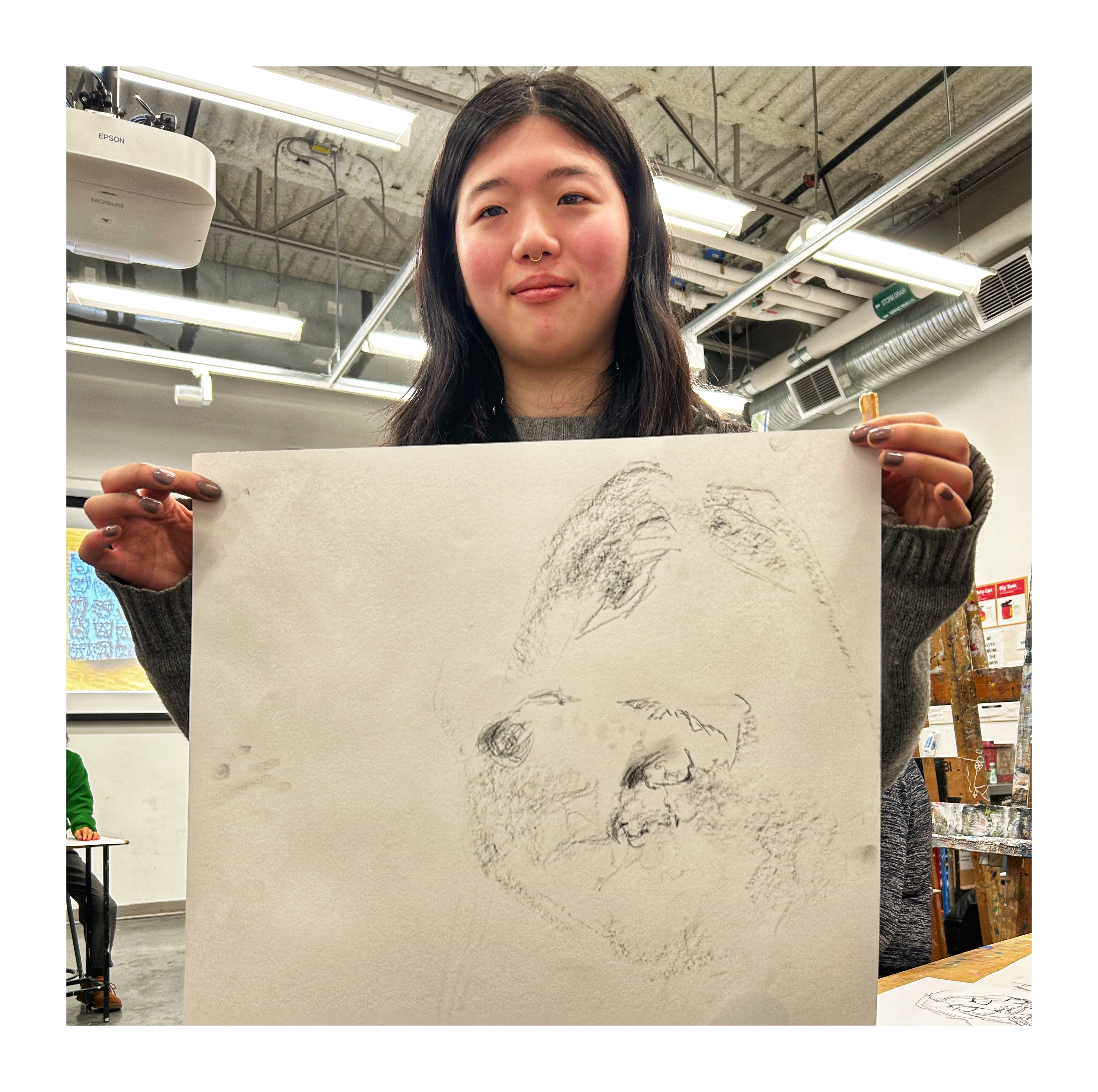

Exploring the invisible via touch, smell, sound, vision and taste. Thank you everyone for sharing your creativity.
Synesthesia PDF
V. Sager
Room D4380
Jan 30 2024
BEYOND VISION
![]()
![]()
![]()
![]()
![]()
A BIG THANK YOU to everyone who attended first event of the Drawing the Invisible / Spring 2024 drawing series. It has been a great pleasure to see some familiar faces and meet new drawing enthusiasts. Looking forward to next session on Synesthesia / Feb 13th.
Beyond Vision PDF
V. Sager
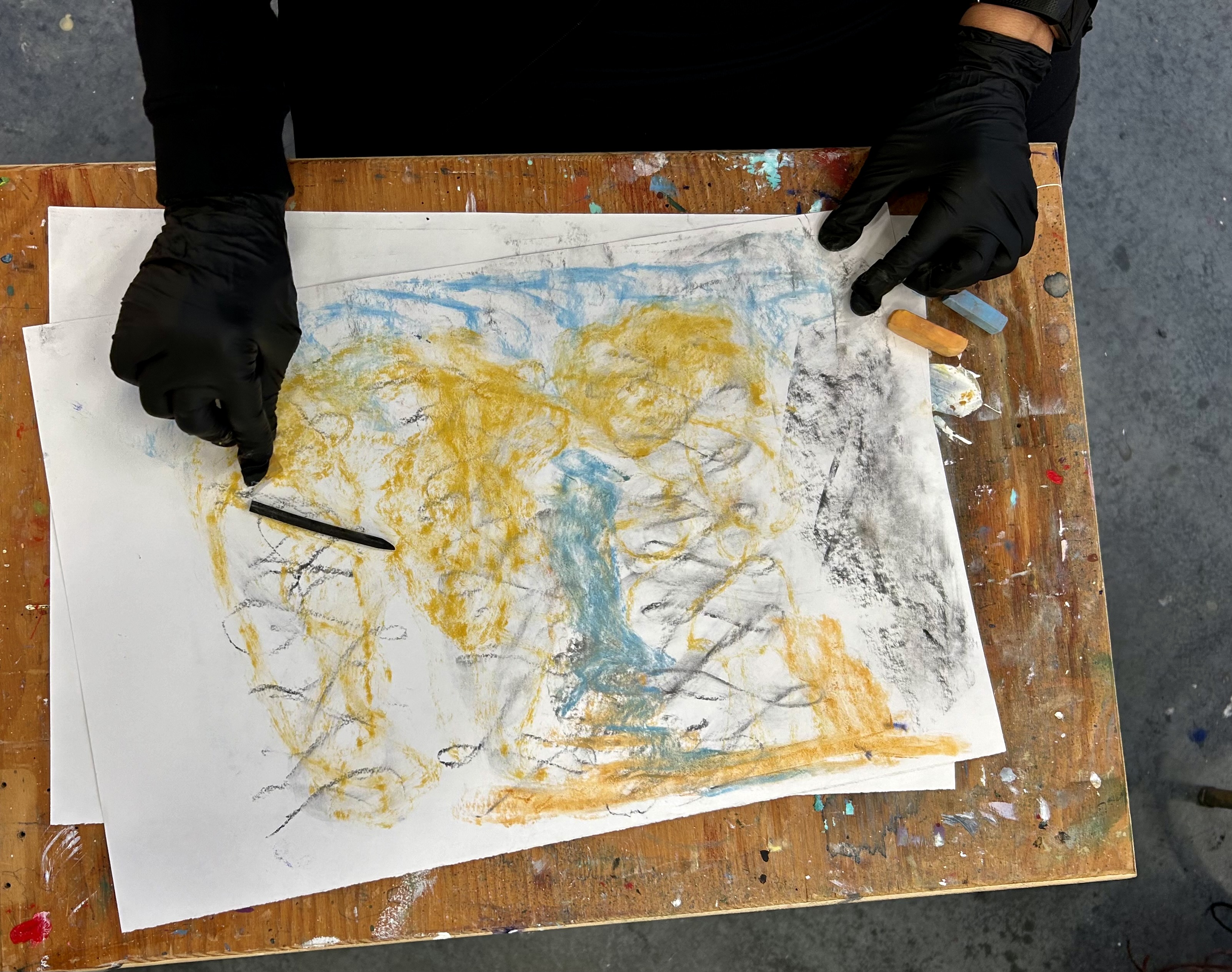

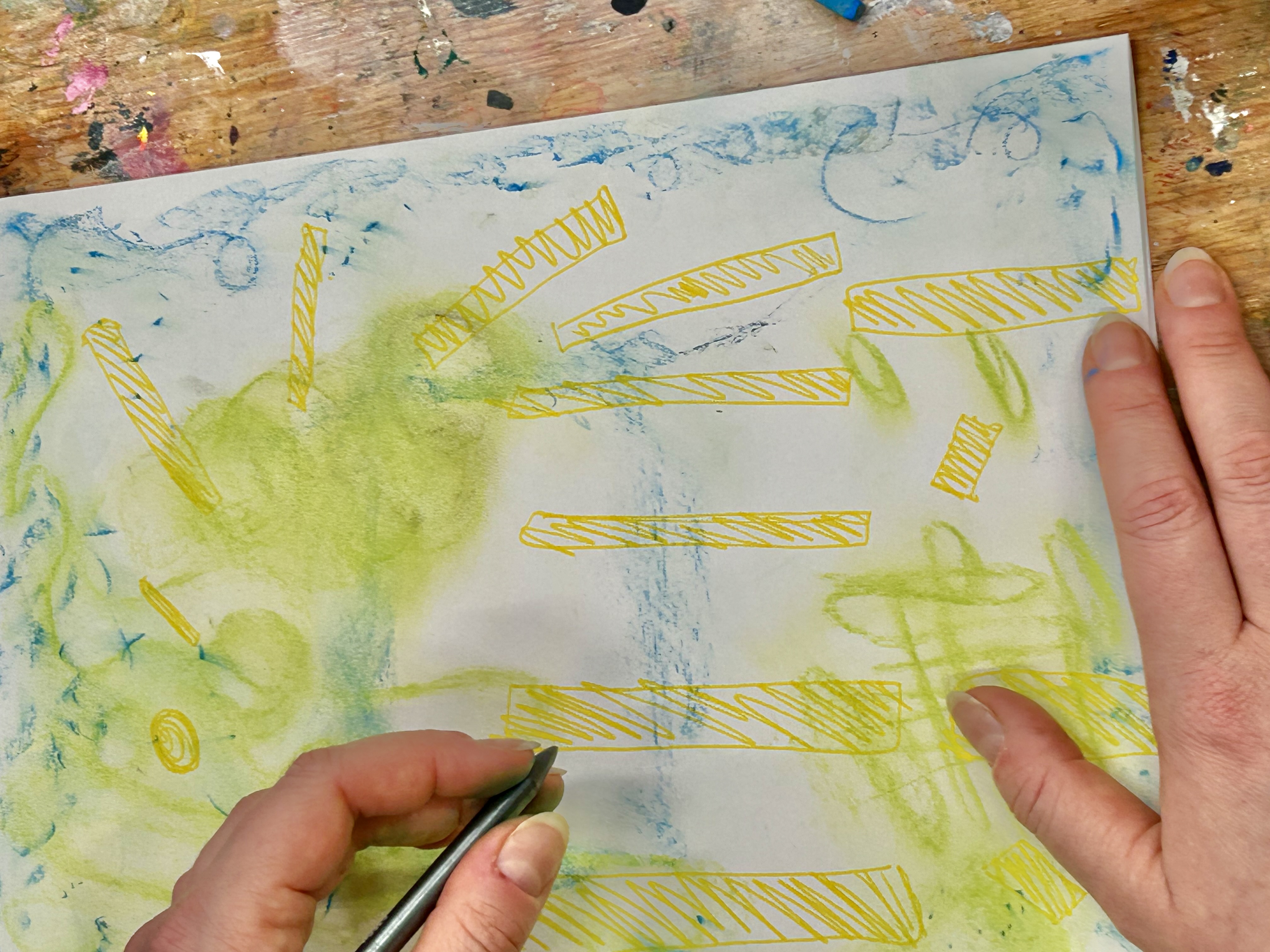
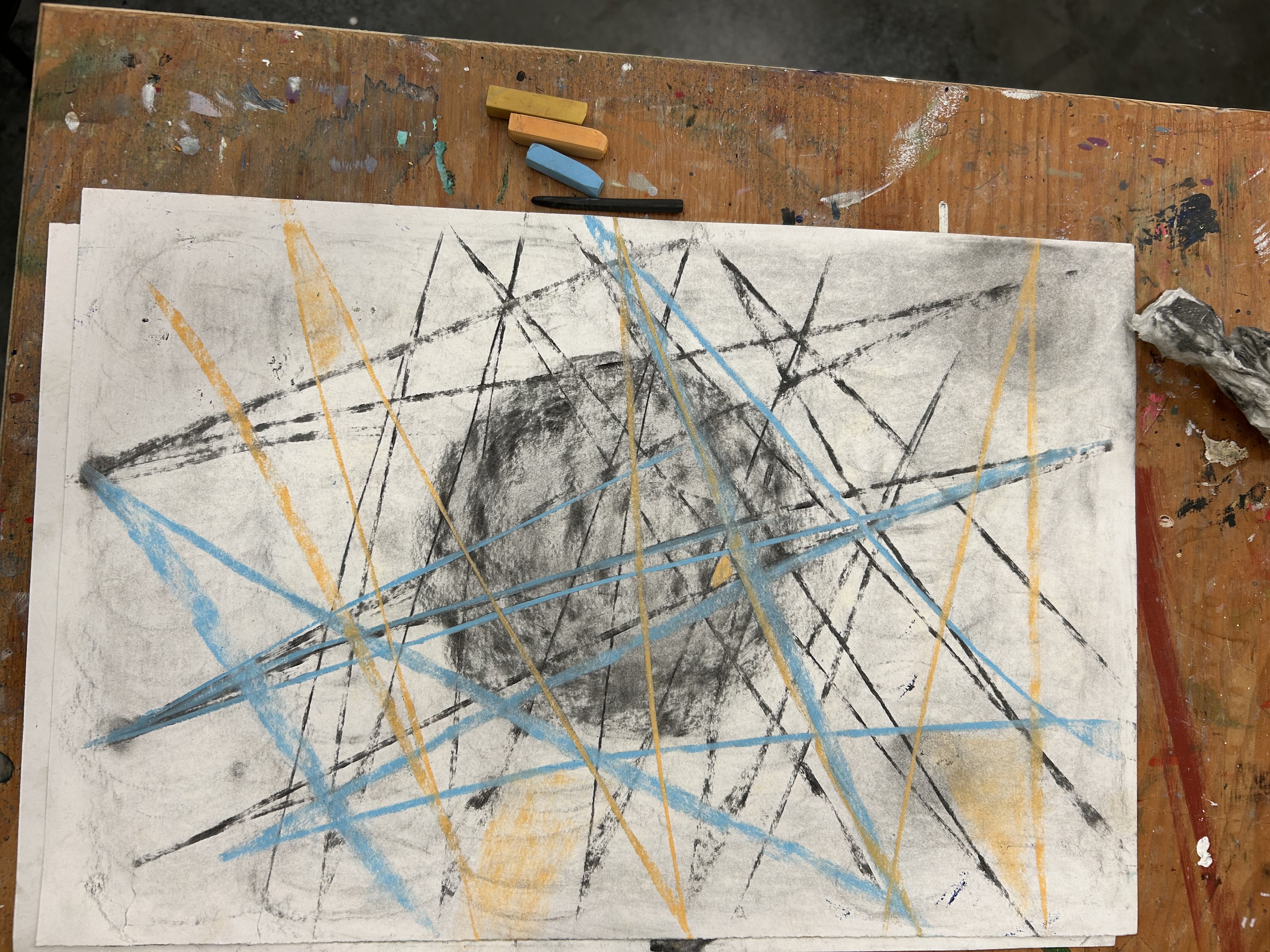

A BIG THANK YOU to everyone who attended first event of the Drawing the Invisible / Spring 2024 drawing series. It has been a great pleasure to see some familiar faces and meet new drawing enthusiasts. Looking forward to next session on Synesthesia / Feb 13th.
Beyond Vision PDF
V. Sager
Room D4380
Oct 19
Fall 2023 : CHARCOAL techniques + methods
![]()
![]()
![]()
![]()
![]()
Dirty hands & clean mind...
PDF - event presentation Charcoal
V. Sager




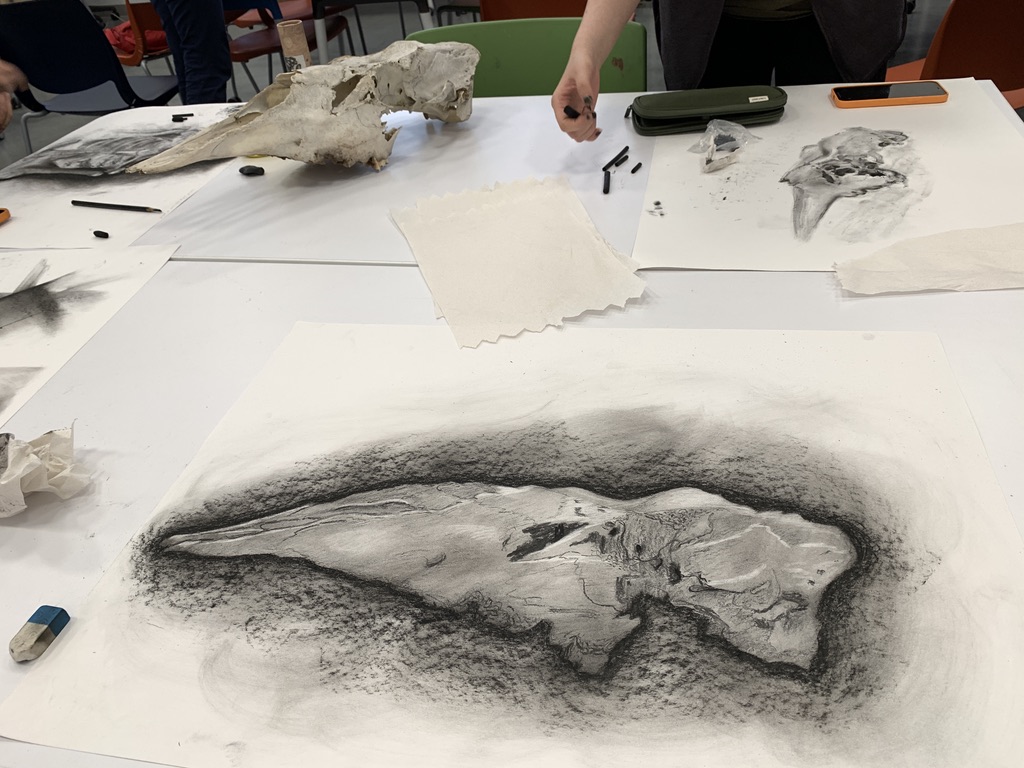
Dirty hands & clean mind...
PDF - event presentation Charcoal
V. Sager
Room C3255
Oct 5
Fall 2023 : PENCIL techniques
It has been a delight to see the classroom filled with drawing enthusiasts. Thank you everyone who attended :)
![]() Hope everyone got something out of demos, talks, interactions and other ways of engaging in creativity and magic of drawing.
Hope everyone got something out of demos, talks, interactions and other ways of engaging in creativity and magic of drawing.
PDF - presentation from the event Pencil
V. Sager
It has been a delight to see the classroom filled with drawing enthusiasts. Thank you everyone who attended :)
 Hope everyone got something out of demos, talks, interactions and other ways of engaging in creativity and magic of drawing.
Hope everyone got something out of demos, talks, interactions and other ways of engaging in creativity and magic of drawing.PDF - presentation from the event Pencil
V. Sager
Room C3255
Sept 21

First event of the Fall 2023 : SKETCHING
As always, Drawing Room attracted students from various departments and years of study, together with drawing practitioners and supporters. We discussed & shared different sketching topics, methods and technical suggestions. The session provided a playground for thoughts, allowing participants to explore the unknown spectrum of their mind. They tested and explored various creative strategies, which will be used to further inspire their creativity.
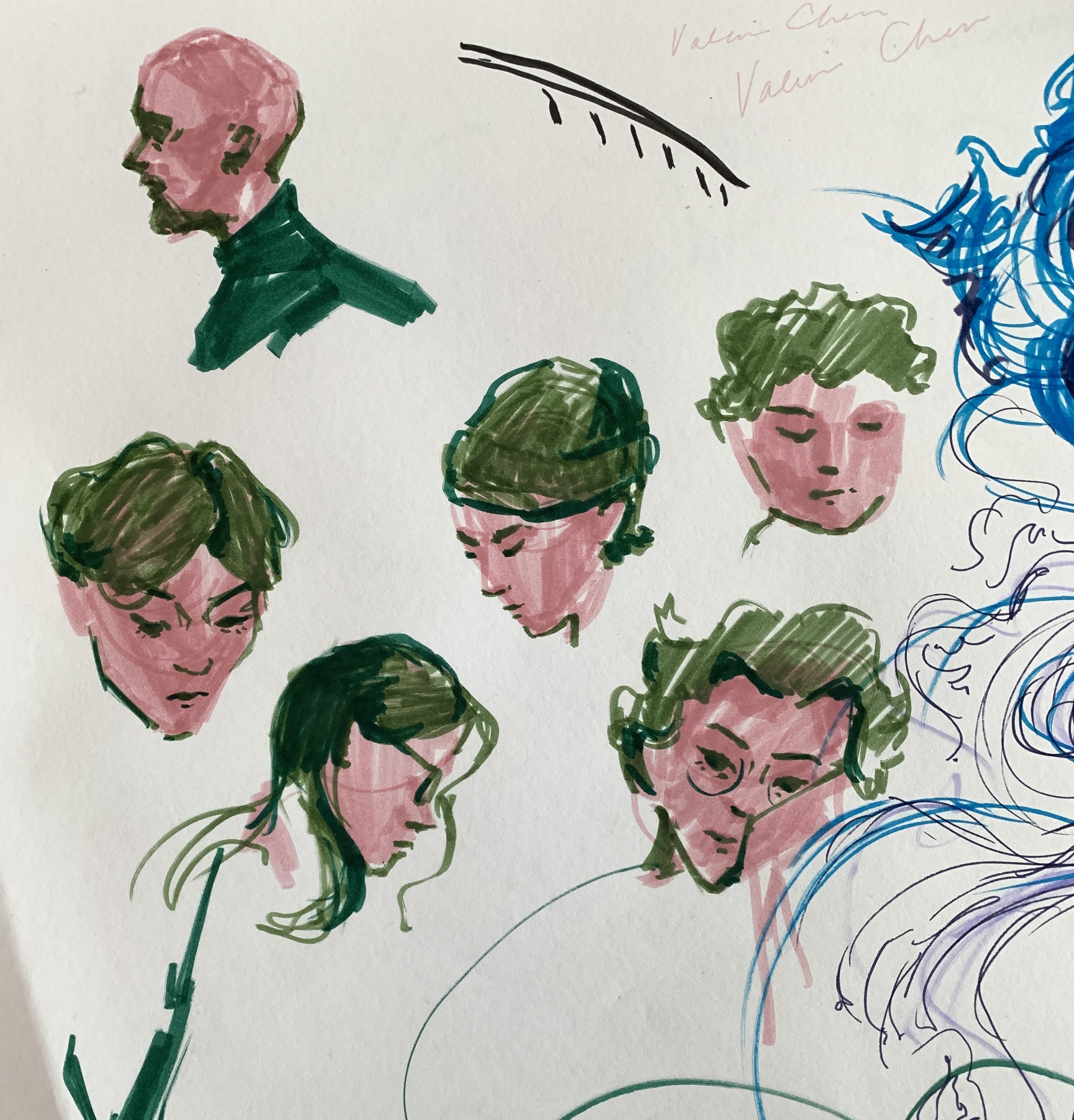
PDF - presentation from the event Sketching
V. Sager
Room C3255
March 16
from 4 PM to 6 PM
 Join us to explore multiple aspects of using the human body as inpiraton in art, design, illustration and other domains of creativity.
Join us to explore multiple aspects of using the human body as inpiraton in art, design, illustration and other domains of creativity. This is the last event of the Return of the Figure drawing series (fall 2022 & spring 2023), curated to examine and explore the role and function of the human figure in 21 Century.
PDF presentation Figure as inspiration
V. Sager
ECU Library
Feb 16
Thursday Feb 16 at 4 PM :: Public Space
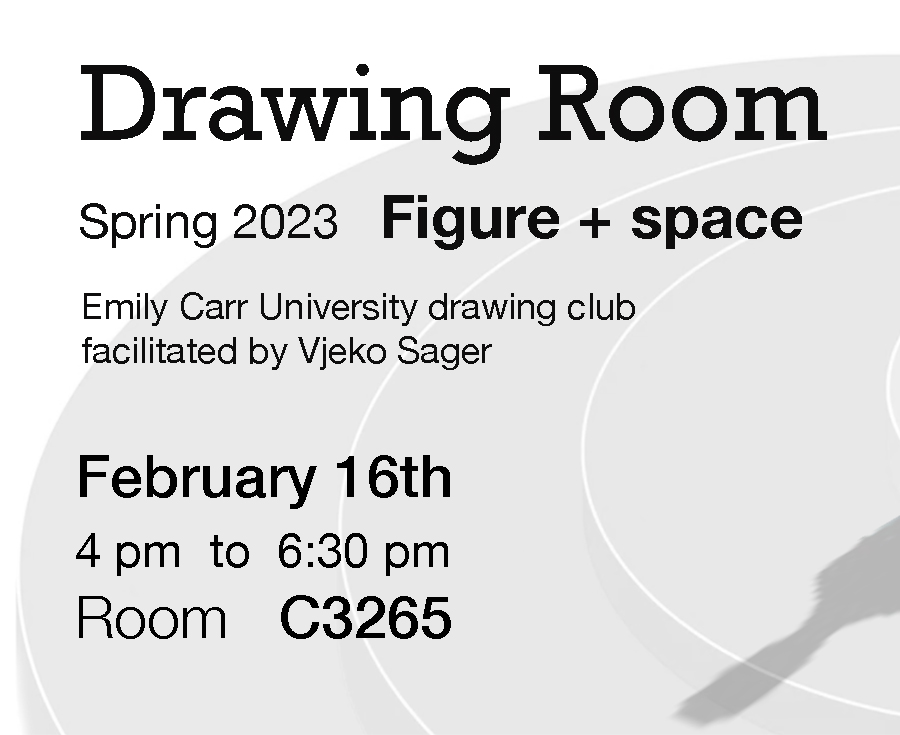 Climate change, economy crisis, pandemics, the tensions between the individual and society...
Climate change, economy crisis, pandemics, the tensions between the individual and society...Enjoy while you can & come and draw.
PDF presentation Figure + Public Space
V. Sager
Room C3265
Jan 26
Private Space
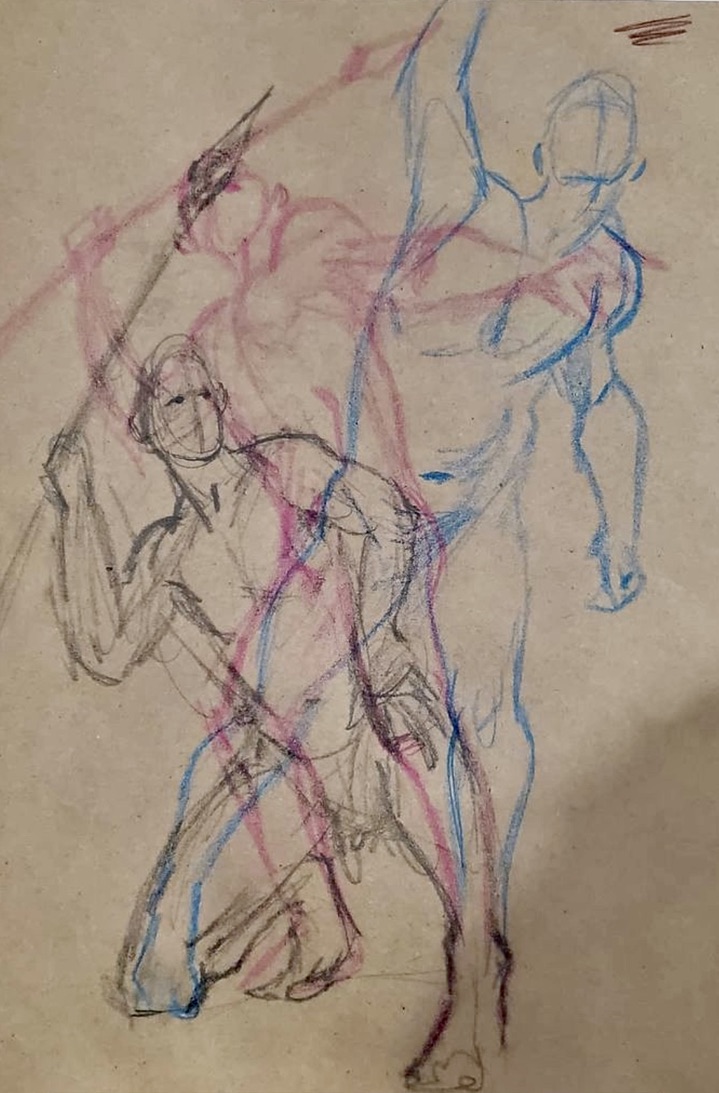
-
What is the Private Space in times of technology?
-
How to draw interactions and events in the surroundings?
-
What happened to creativity after COVID19?
Private space : PDF presentation
V. Sager
Room C3265
Nov 17
Skin + Art





This was the final event of the Return of the Figure drawing series, which focused on skin as artistic inspiration and subject. It has been a great pleasure to chat and explore many different ways the human skin has been used as a canvas, map, mark, decor and experimental surface in different times and occassions.
Thank you everyone who joined and participated.
PDF presentation
V. Sager
ECU Library
Nov 3
Hybrid Creatures



Life figure drawing with model attracted great number of students from every department of the school, including guests, former students, professional creators and art enthusiasts. The painting studio was filled with creative energy, as everyone was focused on exploring hybrid creatures. Thanks everyone for coming!
PDF presentation
V. Sager
D4380
Oct 20, ‘22
Body Dynamics
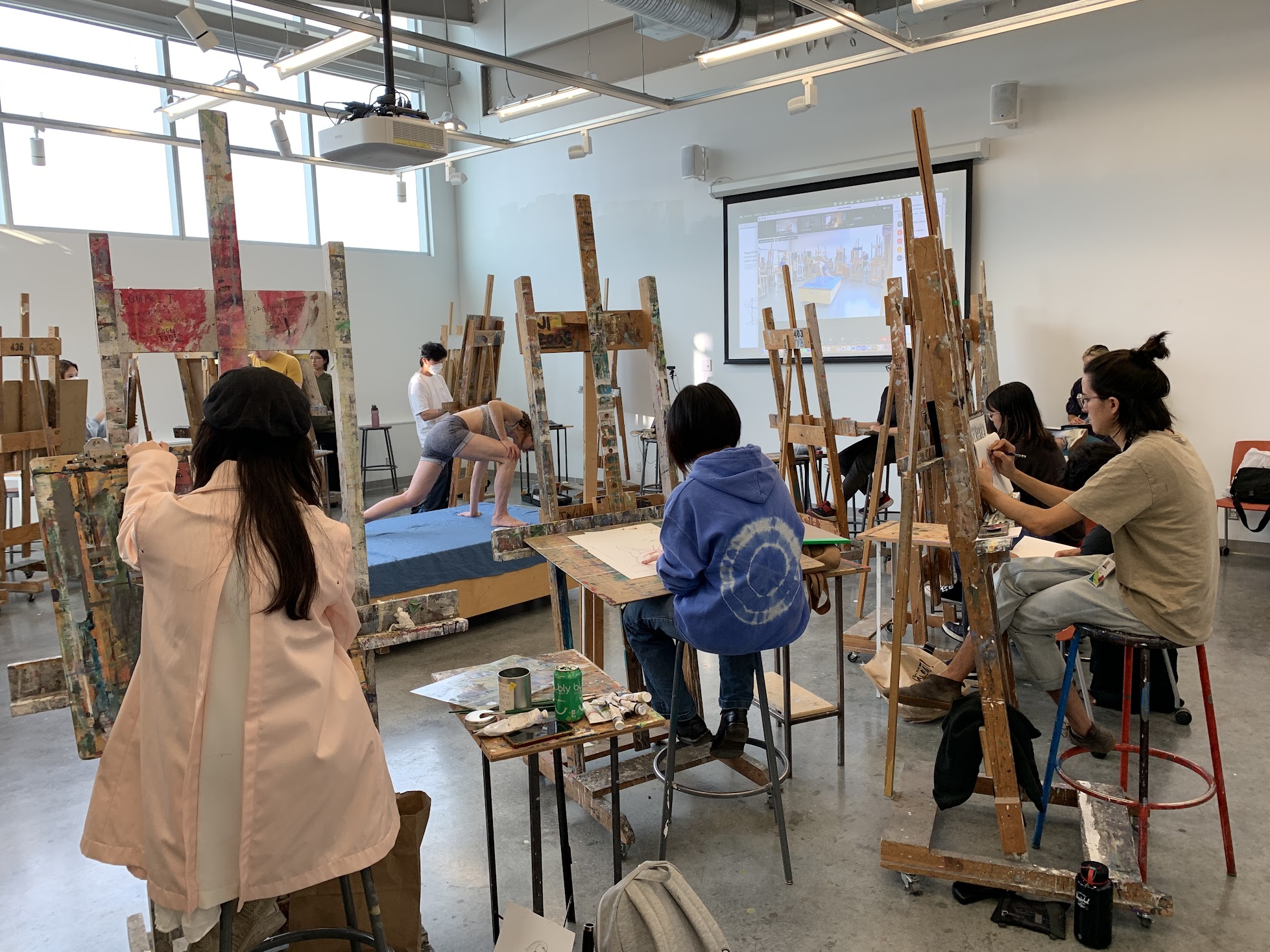


This vibrant and dynamic session attracted many participants who joined in person or online via Zoom. Our model delivered an incredible variety of dynamic poses, ranging form 15 seconds to 5 minutes. Participants produced hundreds of drawings & sketches, which will become a valuable resource for futher inspiration and creative investigation.
PDF presentaion
V. Sager
D4380
Sept 29, ‘22
Body Structure
PDF presentation
V. Sager
D4380
Fall 2022
Return of the Figure

Drawing series dedicated to investigate the human body using life figure drawing with models focusing on interdisciplinary approach and methodology.
V. Sager
D4380 &
ECU Library
ECU Library
3rd Birthday
Sept 15, 2022
Fall 2022 :: LIVE :: Back to drawing & sharing in person
![]()
Follow Drawing Room on Instagram

Follow Drawing Room on Instagram
ECU Library
Draw & talk
March 31, 2022
All the good and bad in you will somehow show in your drawing. - Leonardo da Vinci
![]()
V. Sager

V. Sager
ECU Library
Dot Theory
March 17, 2022
- V. Sager
The dot often remains understated or neglected, maybe because of its size. However, the dot frequently plays a crucial role in communication and carries strong psychological and visual messages.
V. Sager
ECU Library
Drawing Cafe
March 2, 2022
Stendhal syndrome
 Stendhal's syndrome or Florence syndrome is a psychosomatic condition involving rapid heartbeat, fainting, confusion and even hallucinations, allegedly occurring when individuals become exposed to objects, artworks, or phenomena of great beauty and antiquity. - Wikipedia
Stendhal's syndrome or Florence syndrome is a psychosomatic condition involving rapid heartbeat, fainting, confusion and even hallucinations, allegedly occurring when individuals become exposed to objects, artworks, or phenomena of great beauty and antiquity. - WikipediaIt takes its name from the French writer Marie-Henri Beyle, better known by the pen-name Stendhal, who, in 1817, wrote of his trip to the Tuscan capital: "I was in a sort of ecstasy from the idea of being in Florence… I was seized with a fierce palpitation of the heart… the well-spring of life was dried up within me, and I walked in constant fear of falling to the ground."
Article “Having as Art Attack” form Psychology Today
read the article
Pictures and Tears by James Elkins
This is a book about people who have had strong emotional reactions to artworks. It tells a history of times and places when strong passions were expected, and contrasts them with the habits of the last hundred years. The book also has letters from people who have cried, and those who haven’t or wouldn’t. - James Elkins

Drawing as Language
Conversations touched on many topics, including creativity, process, role and meaning of drawing today. According to participants, drawing reflects our times in many ways, as it provides a link among various properties of knowledge. Darwing communicates ideas and concepts, using a form of visual language.
Widewalls magazine: “How do we define visual language”
read the article
V. Sager
ONLINE
via Zoom
via Zoom
Philosophy
February 15, 2022
Pshychology of Line
“Perhaps no one before Klee had “let a line dream.” The beginning of the line’s path establishes or installs a certain level or mode of the linear, a certain manner for the line to be and to make itself a line.”
- Merleau-Ponty, Eye and Mind

Psychology of Line 11MB
V. Sager
ONLINE
via Zoom
via Zoom
Return to Sender
November 18, 2021
Philosophy Day + drawing + conversations
World Philosophy Day is an international day proclaimed by UNESCO to be celebrated every 3rd Thursday of November.
drawing together and chatting about creativity...
merging words and pattents ... anatomy and memories... delicate lines... questions and comments... emotions and colours...& getting inspiration from each other.
V. Sager
World Philosophy Day is an international day proclaimed by UNESCO to be celebrated every 3rd Thursday of November.
drawing together and chatting about creativity...
merging words and pattents ... anatomy and memories... delicate lines... questions and comments... emotions and colours...& getting inspiration from each other.
V. Sager
ECU Library
LIVE at the ECUAD Library
Thursday, Nov 4th
Drawing Room is back to ECU Library.
![]()
Drawing Room is back to ECU Library.
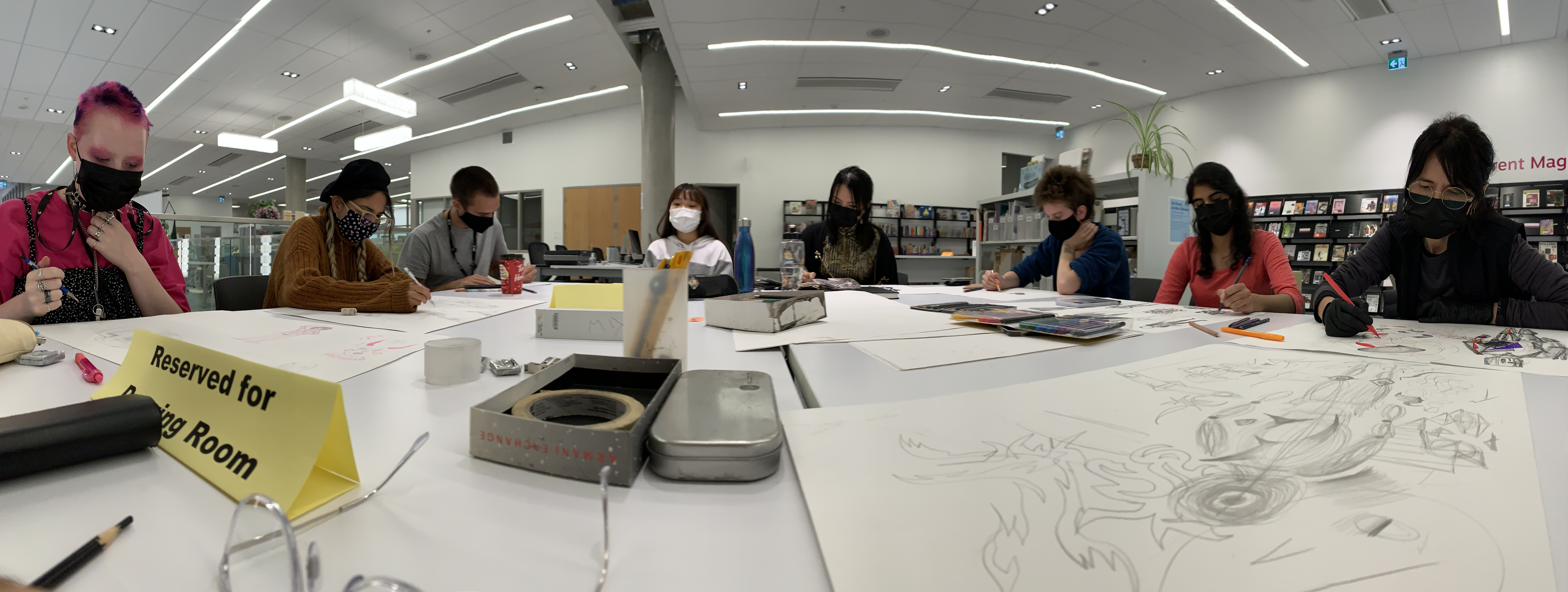
Back to ECU Library
October 7It has been a great pleasure to share experiences and chat about drawing & creativity IN PERSON. After endless online hours and virtual Zoom sessions, real life proves to be refreshing and intimate, open and vibrant...allowing us to see each other’s process and chat while drawing.
Poesis
![]()
A great number of spontaneous drawings appeared on papers, influenced by conversations.
Jenny
It has been a pleasure to meet students and share inspiring moments, discuss ideas and reflect on life.
Spontaneous conversations encourage intuitive and emotional drawings.
V. Sager
Poesis

A great number of spontaneous drawings appeared on papers, influenced by conversations.
Jenny
It has been a pleasure to meet students and share inspiring moments, discuss ideas and reflect on life.
Spontaneous conversations encourage intuitive and emotional drawings.
V. Sager
Back to Drawing Room
October 1st / online
October 7th / ECUAD Library
Drawing Room :: doodle, sketch and join drawing conversations ![]()
October 1st : INKtober - get ready for drawing every day
Learn more about inks here
October 7th : Drawing Room 2nd Birthday ︎
Drawing together and sharing the passion for creativity.
︎ Stay safe: bring mask and proof of vaccination︎
V. Sager

October 1st : INKtober - get ready for drawing every day
Learn more about inks here
October 7th : Drawing Room 2nd Birthday ︎
Drawing together and sharing the passion for creativity.
︎ Stay safe: bring mask and proof of vaccination︎
V. Sager
STYLE
June 3, 2021
Drawing in Style
Style is an easy way of saying complicated things.
- Jean Cocteau
PDF presentation Drawing in Style
Most artists are desperately searching for personal style, despite its limitations.
True (historic) style involves more than resemblance or sequence of similar artefacts. It requires everything to be converted under the paradigm. This way (ex. Gothic) style incorporates architecture, philosophy, religion, art, design and everything else which follows the idea of the Gothic criterion.
Therefore, it is impossible to have style in only one medium, like painting. Despite the paradox, most artists follow a mannerism, which is nowadays described as “style”.

MIND & SKY
May 20, 2021
Anatomy of Clouds
One must always draw, draw with the eyes, when one cannot draw with a pencil.
― Balthus

PDF presentation Anatomy of Clouds
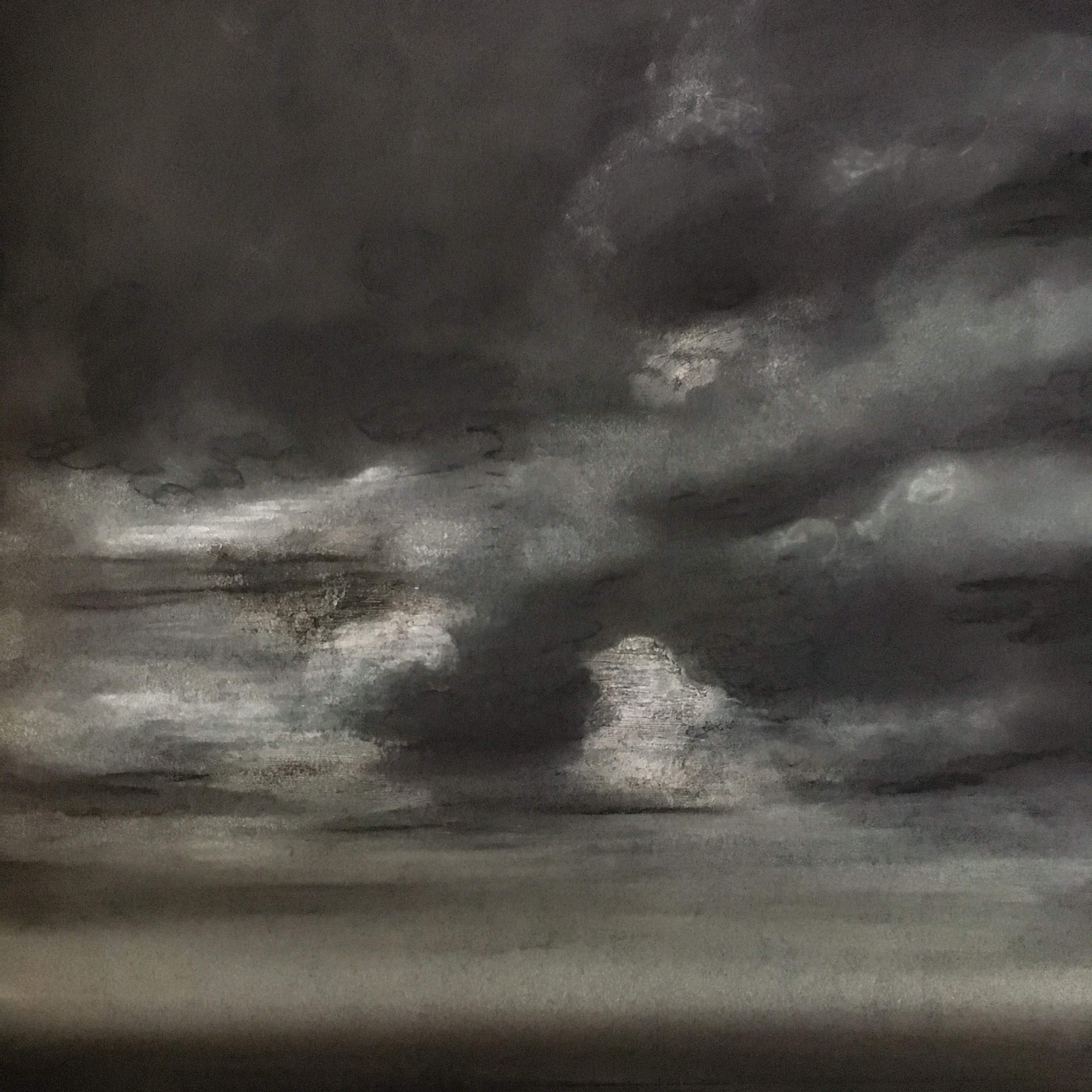
Clouds are everywhere, in the sky, in the mind, artificial or real.. light, airy, dark or furious, they surround us with their permanent impermanence, continuously altering our living conditions. Often we remain blind to their presence, as we usually look onto the ground...and only when we take a photo of the skies, we become aware of their presence.

This session inspired a conversation about skies, clouds, colour, tone... and many more...allowing participants to share their creative experiences and various drawing techniques and methods.

After exploring this topic, most of us will stop looking into the ground and start watching the ever changing landscape above our heads.
V. Sager
WHY DRAW
May 6, 2021
Article on drawing
“None of them knew how to draw because their teachers didn’t know how to draw. That’s the basis of it. You now have people who are more interested in conceptual art – which is actually what you do if you can’t draw… I don’t go into open studios for young artists any more because I lose the will to live… There’s no passion and no originality.”- sculptor Michaels Sandle
(read full article in The Guardian)
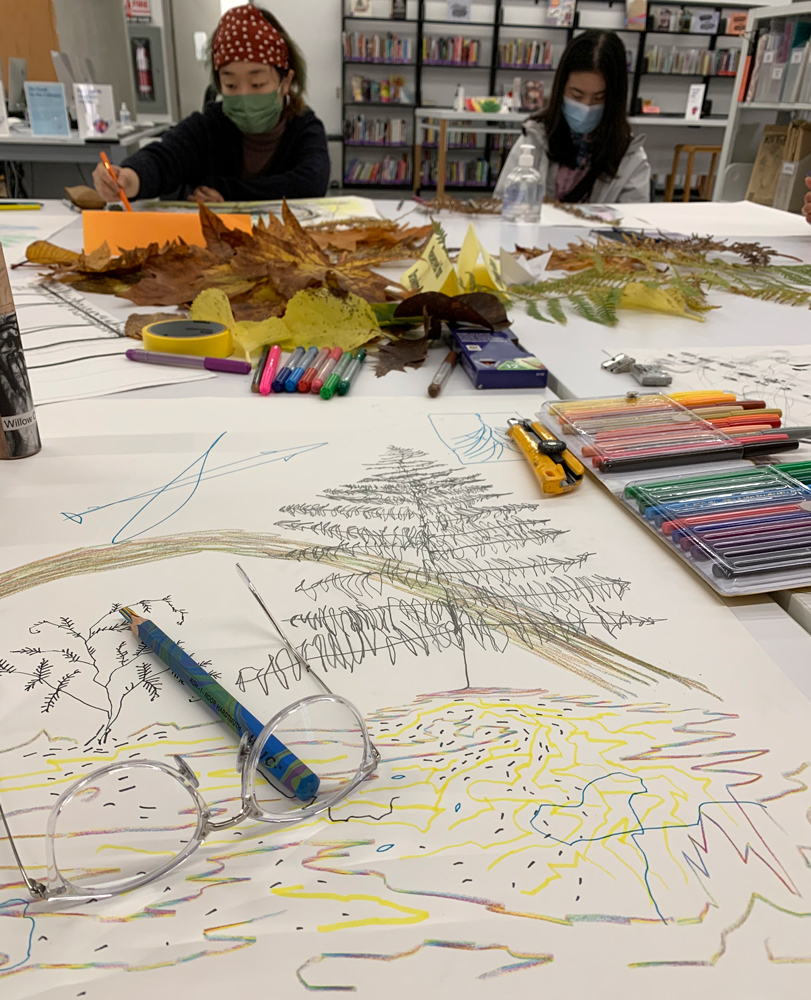
Drawing has its ups and downs, depending on the spirit of times. Sometimes, it is highly regarded as an independent medium and in the next moment it is completely marginalized and pushed away in the background. This is not a strange occurrence, since drawing historically used to fluctuate in between “sketch” (preparation for an artwork) and “illustration” (narrative or descriptive drawing).
First of all, there is a general misunderstanding what drawing is about. Term to “draw” means to pull, move, get closer and in touch with the world. By drawing ourself closer, we start noticing what is otherwise imperceivable or remains unnoticed. To draw means to see beyond perception, to notice nuances and relevant details. Drawing form observation provides us with opportunity to test our endurance, patience and dedication to learning. To draw something means to gain understanding and remember it. In fact, everything we draw becomes in some way a part of us and our experience. This is the first lesson drawing offers to those who are brave enough to pursue unforeseeable directions of creativity.
Next lesson comes from visual culture which deals with image-making strategies. Images are either constructed from perception (observation, study) or from imagination (doodle, abstract). Traditionally, drawing has been associated with observation and studying of objects (still life) or human figure (mythology, narrative). However, a great number of images include both perception and imagination, resulting in fantasy and artistic stylization. Drawing provides us with a unique possibility to record subconscious and mental imagery, to visualize dreams, emotions and instinctive gestures. This means drawing has capacity to handle every image-making concept and method, regardless its origin.
The most frequent reason to avoid drawing are poor drawing skills. This is true and reasonable drawback for everyone who ever tried to make a line on paper. However, best drawings do not rely on skills, but on sincerity. According to Leonardo Da Vinci, most people are unable to draw a sincere line on paper and this is the main reason why they avoid drawing. According to a Master, skills could be attained and developed over time, but sincerity cannot.Where the spirit does not work with the hand, there is no art.
― Leonardo da Vinci V. Sager
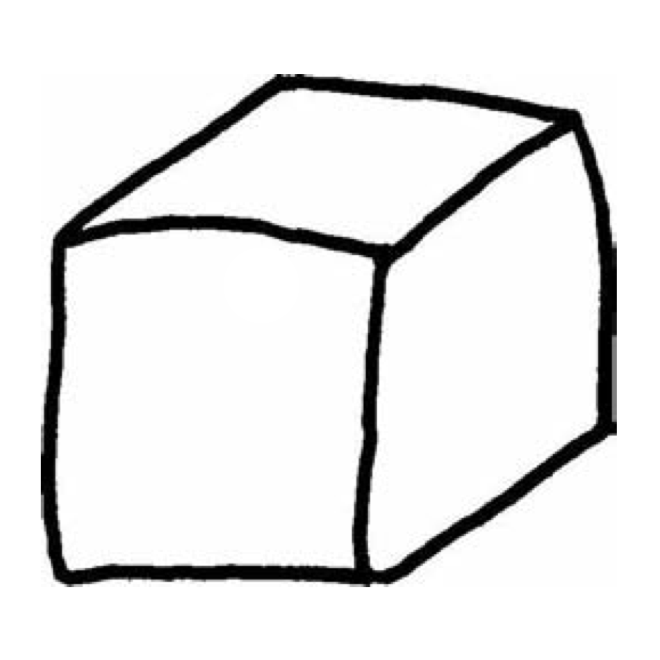
CHILL & DRAW
April 6, 2021
Relax + Create
You are invited to join SUMMER SESSIONS to draw & chat together. These informal gatherings are opportunity to keep your drawing & creative skills alive. Bring your drawings for feedback, ask questions and share your ideas. Talk about various subjects such as creative process, artistic inspiration, philosophy of life, music, art, history, drawing techniques & materials... and many more.

Relax, draw and participate.
Drawing Room CHILLOUT SESSIONS every second week.
V. Sager
Feed:bacK
April 22, 2021
Random thoughts
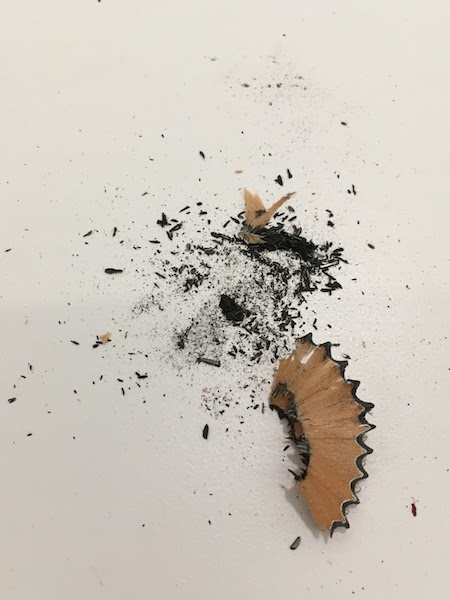 Ungoogleable is something that cannot be "googled" – i.e. it cannot be found using the Google search engine.
Ungoogleable is something that cannot be "googled" – i.e. it cannot be found using the Google search engine.Google is programmed to bring “relevant information” to masses. If you search for “drawing”, Google will retrieve all sort of things except a genuine drawing.
Drawing from photographs
Drawing is in opposition to photography. However, most people use photography as a main source of inspiration, forgetting that photography is a “negative blink”, or a snapshot made out of reflected light/photons.
On the other side, drawing provides us with ability to perceive our imagination and retrieve images form memory. These images are not photographic, but distorted and fragmented. For this reason, style is a difference between (photo-based) reality and artistic expression. In other words, art is interpretation, not a description of reality.
In other words, those who use photography as a reference and inspiration, must feel distant from art and intimate with Google.
Keeping Basics Alive
Due to impatience and curiosity, we intend to quickly abandon basics. However, fundamentals are indispensable component of every visual expression, including drawing. For a musician, it is crucial to practice “scales” and for visual artist, it is essential to draw variety of tonal values. Every dot, line and plane reflect our understanding of basics and there is no shortcuts to produce a masterpiece, without regular practice of elements.

V. Sager
Reverse Creativity
April 8, 2021
The session was dedicated to explore many aspects of creativity by taking the journey backwards, as only when we reflect, we may understand the present.
Cubist-like conversations
Drawing Room’s participants are the most valuable aspect of this project, as they come from different backgrounds and are interested and willing to share their perspectives on drawing. Diversity of thinking makes conversations vibrant and unpredictable, same as the act of drawing. Unique viewpoints generate multifaceted discussions, similar to cubists’ attempt to draw an object using different points of view.
Drawing & dialogue

Conversation on reverse creativity started with Martin’s comment on division among skills-techniques-creation, stating that learned skills maintain and allow continuous creativity. In other words, practice supports creative process, similar to a “creative muscle” which needs to be maintained through exercises.
Fred introduced term “system” as a connection among elements (throughout the Universe) which produce creative force in every given moment. In other words, understanding relationships among all things provides inspiration and nurtures creativity at any given time in historic terms. In some way, systems generate stylistic preferences, based on our knowledge and believes.
Poesis brought a theme of inherent creativity, as we are all “born creative”. In this sense, creativity could be only stimulated, not learned.
Maria pointed out to a double-sided influence of internet, which behaves as a poison or “pharmakon” (Greek for drug), depending on a dosage. Martin confirmed the internet is like a Pandora’s box, often delivering manipulated content, which cannot be taken for granted. He pointed out to students’ unwary habits of using Google for inspiration, which produces calculated results instead genuine knowledge. He highlighted the importance of book as an edited & curated knowledge-resource.
Conversation touched on different creative issues, such as “when to stop making art”, “how to alter tools to provide best expression of the idea” and continued by sharing personal creative examples and discussing history of arts, psychology, philosophy, science, crafts and many other aspects of creativity.

Memory Drawing
March 25, 2021
Mnemosyne
 Mnemosyne, a mother of nine Muses, remains the most important link between thinking and drawing.
Mnemosyne, a mother of nine Muses, remains the most important link between thinking and drawing.
The ancient Greeks, to whom a trained memory was of vital importance (as it was to everyone before the invention of printing) created an elaborate memory system, based on a technique of impressing 'places' and 'images' on the mind.
In order to train the eye to see and mind to remember, we started with “eye tracking” exercises. We continued to train our memory by copying the photos and remembering the images. Mapping the walk form memory and discussing many aspects which define memory and drawing.
Drawing heavily depends on memory, as our skills are in direct connection with training and practice. Hand, eye and mind need memory as a guide to control and create marks on paper which consequentially produce an image we call drawing.
V. Sager

Dance + Drawing
March 11, 2021
![]() Special Event
Special Event
Danielle Basterville and Michael MaryeDrawing Room is thankful to Danielle and Michael for sharing their artistic talents at the Special Event on March 11th, 2021. Participants had an opportunity to explore unique fusion between dance and drawing.

Dot. Line. Plane.
Elements of art follow every occasion and every medium, constantly reminding us of the importance of the fundamentals. Both dance and drawing start with a dot, which moves through space to make a line. Body connects lines, creating an image. Drawing follows.
Drawing and Dance
Every movement is a new word…which we tried to decode…and capture on paper. Bodies in space don’t recognize limitations of two-dimensional surface. Flatness of the paper turns to be the greatest adversary, not allowing line to dance. At that moment, I recognized the power of technology and made my drawing dance, moving it under the lens of the camera.
Every participant perceived a different sensation and everyone responded differently, from large Paula’s action-drawing, delicate Audrey’s mark-making, intriguing Fred’s creatures and Poesis’s dancing architecture.



Danielle and Michael provided us with fascinating interactions, only known to dancers. While mirroring each other, their gestures still reflected their personal signatures. They interpreted a Paul Klee’s drawing, bringing to life his famous saying “drawing is taking a line for a walk”. Nothing is closer to the notion of pure art than a feeling of total immersion, deep reflection and memory of things which reminds us of what we should strive to become.

Further reading
Cissie brought to our attention Erin Manning's concept of technogenesis in her “Relationscapes: Movement, Art, Philosophy”, where this dancer-philosopher directs our attention from the source or the subject of movement to the ecological conditions of co-movement...and so the movement of hands and instruments across paper, with the movement of bodies in space but also on and off floors, come together as one singular set of generative material gestures across each of our suspended but embodied virtual spaces.
V. Sager
Anatomy of Things
February 25, 2021
Conversations about Ideas

Anatomy of Things
Session was dedicated to explore the notion of the “Form” in relationship to the “Idea” (Greek for “form”). Ideas existed independent of reality and according to Plato, they were the ultimate “ideals”, or true existence. Once we engage in translating ideas into reality, we encounter a series of obstacles and possibilities which guide and influence the result, i.e. realization of the idea.
From idea into matter
Most prominent elements in the process of interpreting ideas are intention, medium of our choice, time (presence) and our ability to engage (skills).
Innocence
Intention is often concealed or expressed as a word. We employed term “innocence” to test and explore the importance of drawing objective. The exercise produced abstract sketches which confirmed both authority and freedom of using words to communicate meanings.
 Time
TimeThe element of time is one of the most neglected factors in the process of making art. Most people measure time with the clock, which is an authoritarian and unnatural convention, resulting in quantity instead quality of engagement.
Time is also experienced differently, starting with Buddhists’ spiritual proclamation “here & now” (in reference to eternity), to expressing a physical duration of event, i.e. western notion of “time is money”, which caused one of the greatest misunderstanding of art and creativity, measuring time with minutes and hours.
Time is reflected as the amount of Presence, in a sense of deep and absolute devotion. Presence (in Buddhist philosophy) is decisive in conveying the quality of the idea from mental to perceptive dimension. Duration (western notion of labour and skills) reflects the passage of time regardless the presence. These complimentary perceptions of time generated unbridgeable gaps in historic terms, dividing further all other properties.

Medium
Focusing on medium destroys art. If medium becomes a central point, then creativity is understood as a technical ability or skill. Ability to handle tools is most important, but cannot become a goal in itself. Unfortunately, skills are often regarded as a final objective, producing a “perfectly-boring” craftsmanship. Internet turned to be the most evident depository of skill-driven creativity.
Matter
According to Michelangelo, matter is as well inspiration for creativity, a source of ideas which need to be revealed with artist’s ability to “hold a hammer”. Interaction with matter creates a reverse engineering (a.k.a. inverse creativity), starting with materials and ending with the idea. The notion of “art as matter” has been exploited in western culture starting with Duchamp’s “readymades” and consequentially influencing market-driven art scene.
On the contrary, Buddhists’ meditations are painstakingly turned into sand-mandalas and thrown away when finished. Again, disparities in understanding material world cast different value systems in creating monetary or spiritual richness.
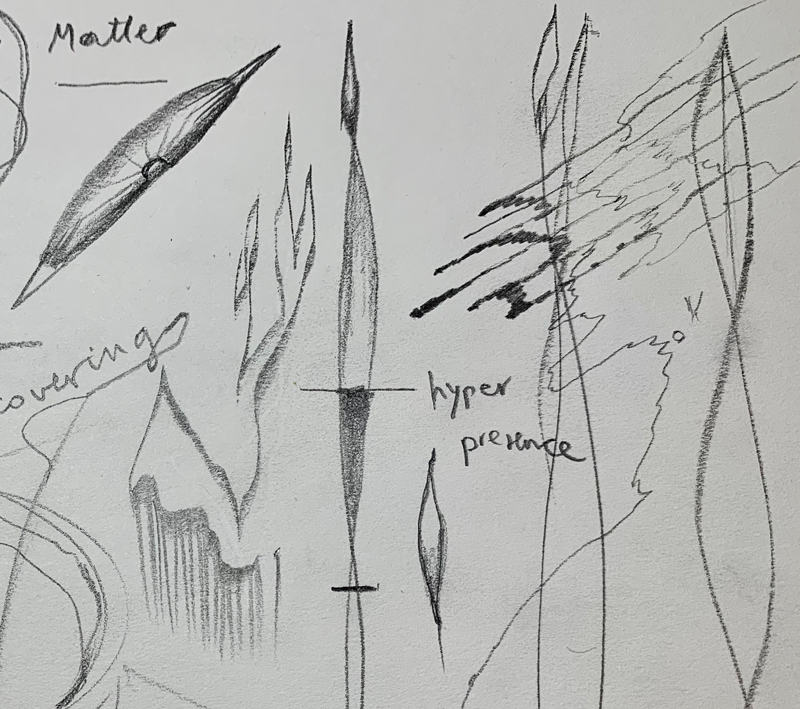
Conclusion
History evolved through philosophy. From the notion of the “idea” as the ultimate goal, to a concept which declares that “form follows function” (a.k.a. material) the relationship in between idea, medium and matter continues shaping our minds and creativity. Drawing is always at the centre of events and it remains the ONLY connection among disparities.
V. Sager

INTERdisciplinary
Learning from Masters
Leonardo da VinciCuriositá: exploring reality, searching for continuous learning.
Dimostrazione: comparing knowledge and experience, learning from mistakes.
Sensazione: keeping your senses wide awake so you can live the experiences.
Sfumato: embracing ambiguity, paradoxical statements, and doubts.
Arte/scienza: keeping the balance between common sense and imagination, between art and science, between logic and absurd.
Corporalitá: keeping the balance between the body and the mind.
Connessione: acknowledging and appreciating the connectivity among all kinds of things.
Drawing exposes bad things in people. - Leonardo
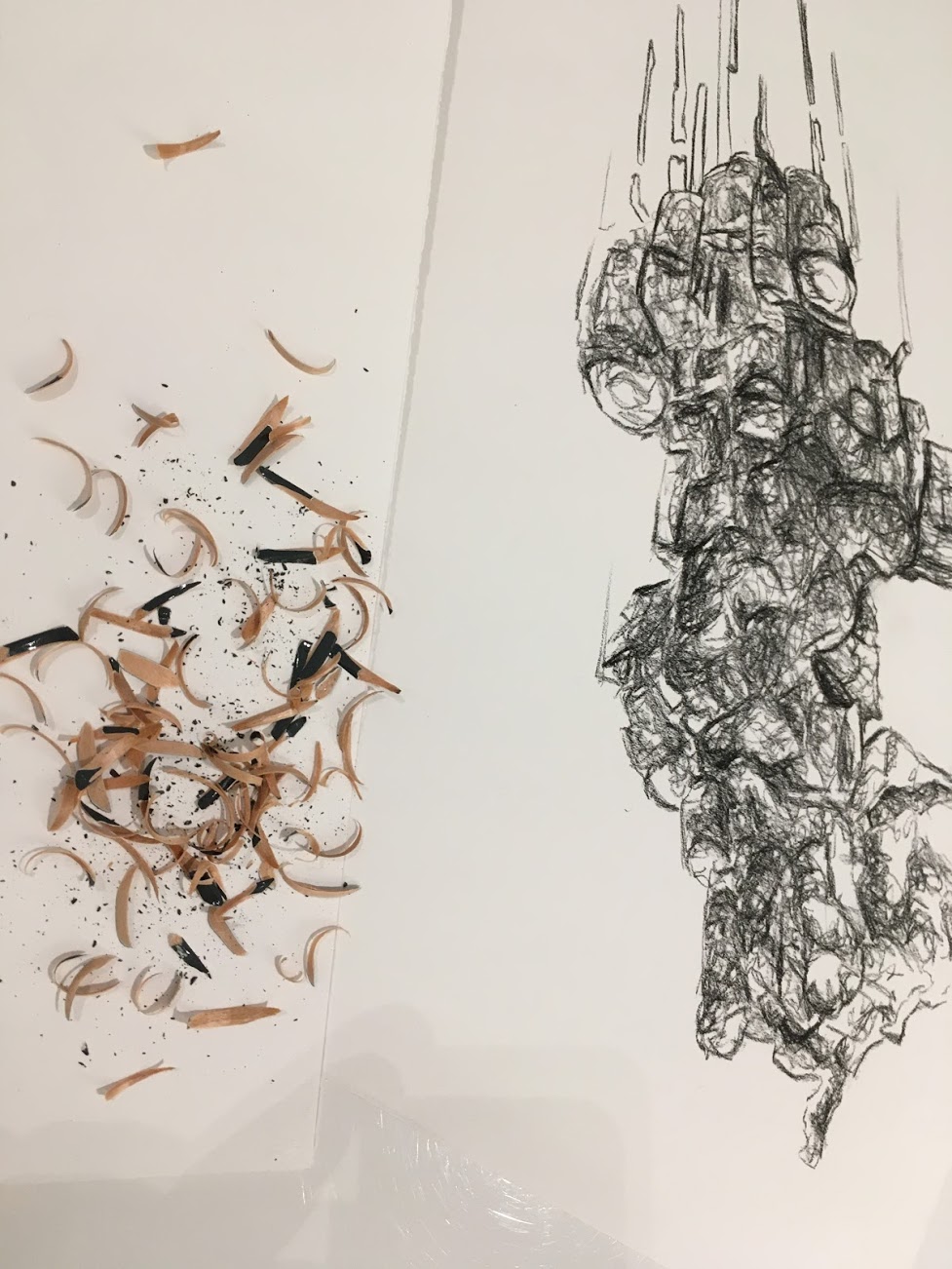
Divide and lose
Over the centuries, drawing has been divided in between disegno interno which follows the internal stimuli (hand guided by imagination) and disegno esterno which follows the model of drawing from observation (hand guided by perception).
This polarization (still) affects all those who make division among ideas and skills, culminating on social platforms (YouTube, Instagram), where disegno esterno manifest itself via skills, or ability to render realistically. This methods is preferred by a large groups of users, as inartistic folks get easily fascinated with someone’s ability to render things “as they are”.
On the other side, drawing which reflects conceptual engagement, may be left unnoticed or ignored by the majority, simply because masses are easily fascinated by external stimuli. To be precise, concepts involve different kind of engagement, often unnoticed by those who search for external visual pleasures.
Some artists merge and combine both methods, generating an array of amalgamations which consequentially give a rise to stylistic questions, further splitting drawing into smaller and narrower corridors of disciplinary thinking. It is possible to say that disciplinary thinking divided two major streams (internal & external ) into a maze of sub-stylistic fashions, which became diluted to the point of losing the entire notion of drawing.
In other words, divisions steer knowledge into disintegration which defragments the entire system of meanings, leaving us speechless and bewildered in front of a genuine line on paper.
V. Sager

INTERdisciplinary
Drawing
Feb. 11, 2021
Drawing
Feb. 11, 2021
Fernando Pessoa
- The Complete Works of Alberto Caeiro
poem #24
What we see of things are the things themselves.
Why would we see one thing if there were another?
Why would seeing and hearing be an illusion
If seeing and hearing are just seeing and hearing?
The essential thing is knowing how to see,
Knowing how to see without thinking,
Knowing how to see when you see,
And not thinking when you see
Nor seeing when you think.
But this (alas for those of us whose soul wears clothes!),
This requires long study,
An apprenticeship in unlearning
And a solitude within the freedom of that convent
Of which the poets say the stars are its eternal nuns
And the flowers devout penitents for a single day,
But where, after all, the stars are just stars
And the flowers are just flowers,
Which is why we see them as stars and flowers.
— The Keeper of Sheep
Thoughts on Composition
January 28, 2021
January 28, 2021
Compose

Picture plane is a space in between inner and outer worlds, imagination and reality. It permanently re:negotiates the position and role of the author, allowing ideas to emerge through organization and arrangement.
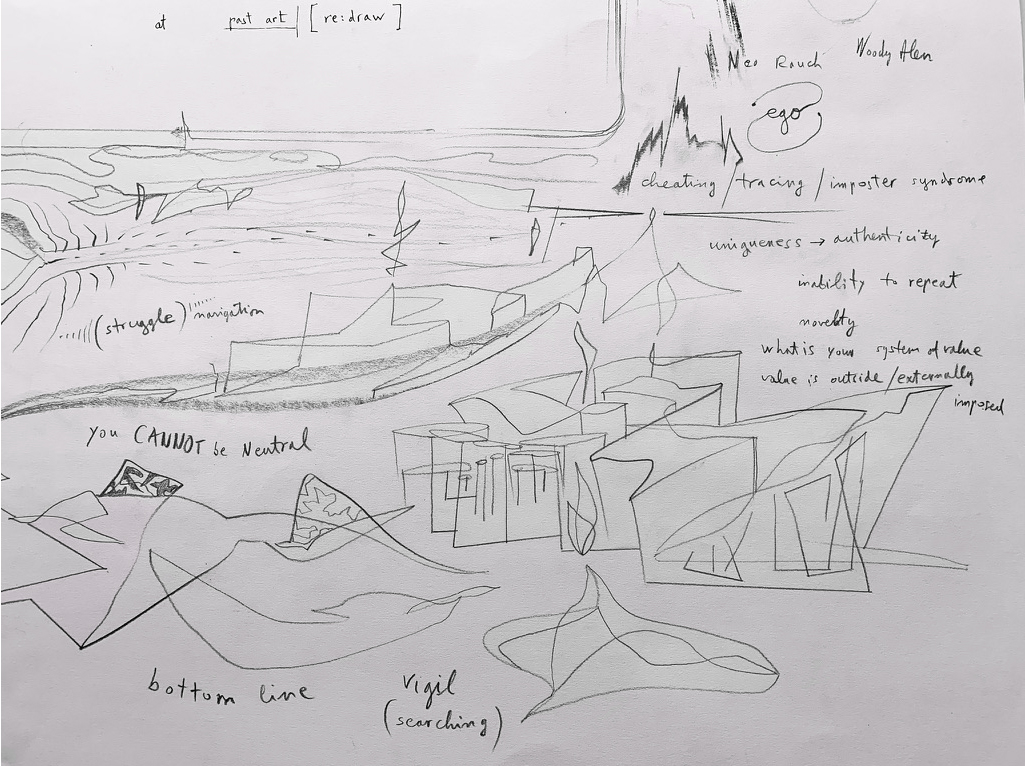
Compositional frame allows (invites) objects and subjects to appear in infinite number of ways, generating unlimited meanings. To compose, means to “com-position”, to tell the story and bring the expressiveness and significane out. No other visual element has more rules and regulations and at the same time, nothing ever allowed greater sense of freedom in breaking those rules, than composing.

Drawing + philosophy
Drawing Manifest
To draw means to pereive hidden relationships among things.
Absolute and unconditional presence.
Hyper-presence. Beyond focus. Timeless. Zone.
Playful and responsive. Lose and win without losing or winning.
Vulnerabilty of permanent beginnings.
Mistakes turned into resolutions.
Fear. Encountered. Turned into inspiration.
Refusing current issues. Abandoning deceptions and false perceptions.
Concept-less. Without goal or purpose. Worship the useless and impossible.
Embrace intimacy. Reject the ego.
Uncover the hidden truth. See the unprecedented and unforeseen links and connections.
Beyond senses, beyond knowledge.
V.Sager
The Space between
Infinity
 Drawing exists in between thought and event of making a mark. It depends on, but at the same time rejects both, reasoning and skills. As every unfinished business, drawing exists in limbo, hanging over the abyss of fear. This way drawing remains anticipation and intention at the same time, never fulfilling or confirming its status. This is the reason why some regard drawing as a secondary medium, or a mere step towards something else.
Drawing exists in between thought and event of making a mark. It depends on, but at the same time rejects both, reasoning and skills. As every unfinished business, drawing exists in limbo, hanging over the abyss of fear. This way drawing remains anticipation and intention at the same time, never fulfilling or confirming its status. This is the reason why some regard drawing as a secondary medium, or a mere step towards something else. However, this position allows drawing to take the advantage of non belonging to any particular domain and turn it into a weapon to penetrate into every discipline. The space in between is the space of unexploited potential.
The most powerful sensation while drawing is a suspension in between hand and surface...the void filled with anticipation to make a mark.
This space has been masterfully depicted in the Creation of Adam, where Michelangelo left God’s and Adam’s fingers lingering in eternal deferment. The absence of contact keeps intentions, desires, hopes and fears in permanent interplay in between possible and impossible, until we make a final decision to touch and discharge only one (possible) mark.
V. Sager


 artists who explore drawing beyond vision
artists who explore drawing beyond vision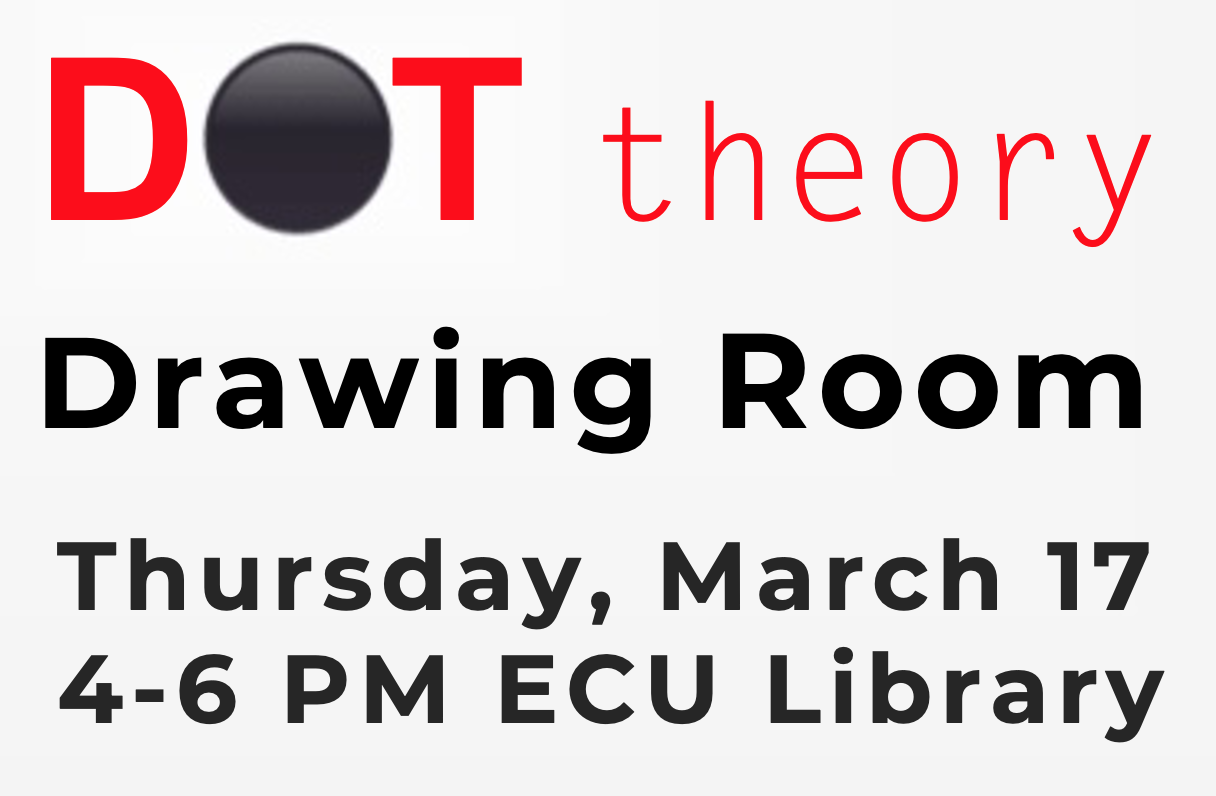

 Special Event
Special Event